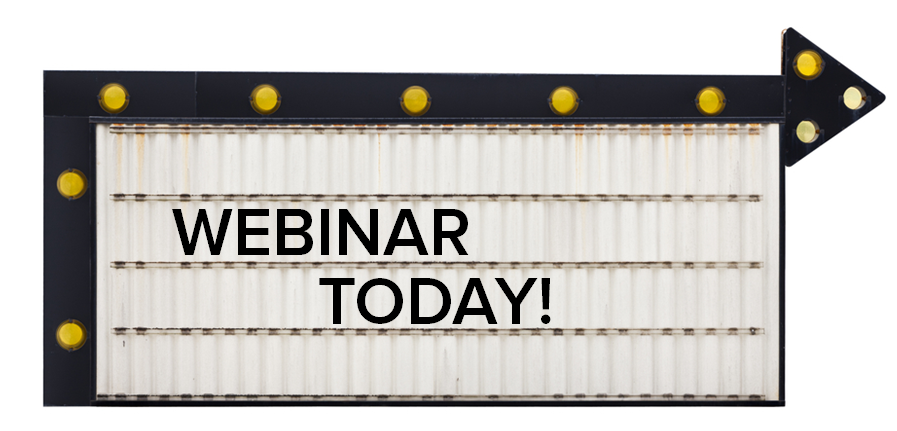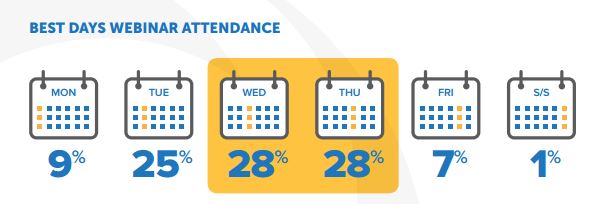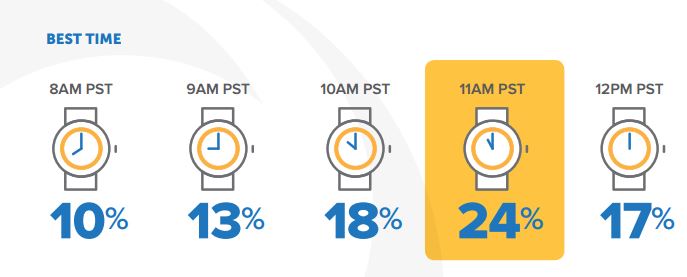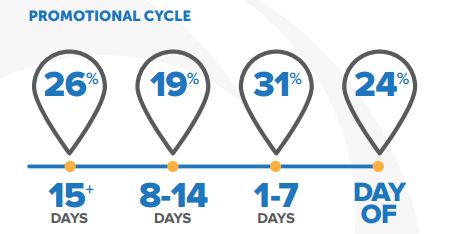You have a lot of decisions to make when planning a webinar:
-
What day of the week should you hold it?
-
How far in advance should you email your database?
-
Will people be more likely to show up for a morning or midday event?
On24 recently compiled data from over 9,300 webinars throughout 2014, and found a number of factors that correlate with successful events. As more companies host webinars to promote their brands – 61 percent already do – you need to find ways to make your event stand out and get the biggest bang for your content marketing investment.
1. Schedule webinars mid-week (Weds, Thurs.)
Wednesday and Thursday are the best days of the week to host a webinar because the average the highest attendance rates. Not surprisingly, Saturday and Sunday had the lowest attendance rates for webinars.
However, the study points out that these numbers are probably inflated because mid-week is also when most companies hold webinars. There’s no data to prove that a Monday or Friday webinar will be less effective for a company that knows its audience is highly engaged on those days.
Pro-tip: Check your Google Analytics data to see which day of the week your audience is engaged on your site. If you see peaks at the start the week, it might be worth exploring a traditionally slower day (like Monday) for webinars to avoid scheduling conflicts. However, if you see a lull in traffic on Mondays, it might be worth waiting until Wednesday when visits pick up for your site.
2. Pick a time that accommodates all time zones
The study found that 11 a.m. Pacific Standard Time was when webinars have the highest attendance. This is perhaps because it’s a time that’s amenable for attendants across time zones. Registrants in New York can tune in at 2 p.m. (after lunch and before the end of the day), while you catch people in Central and Mountain time zones during their lunch hour.
Again, consider your audience when planning your webinar. If you know you have prospects spread across time zones, then you will have to find a time that works for the most attendees. But if you primarily cater to a local audience, you can prioritize a time that accommodates your registrants.
3. Start promoting at least 2 weeks in advance
Over 25 percent of companies send out the first emails inviting contacts to webinars at least 15 days before the event. If you start your promotion campaign two full weeks in advance, you have a larger window to build attendance numbers and remind attendees.
Promotional emails that are sent midweek, Tuesday through Thursday, generally outperform messages that are sent at the beginning and end of the week.
31 percent wait until the week of the event and 24 percent tell contacts the day of the webinar.
Another 31 percent wait until the week of the event and 24 percent tell contacts the day of the webinar. Later sends might be an attempt to keep people from forgetting about an event they’ve signed up for, but you run the risk of low attendance numbers if your audience can’t fit it in last minute. Additionally, “Longer promotional cycles enable marketers to increase the number of email drops while avoiding spamming their mail lists,” the study concluded.
4. Cap it at an hour
Webinar run times generally hover around 56 minutes, up from 38 minutes in 2010. While consumers’ attention spans are shrinking, their desire to absorb information online is growing.
This data suggests that if you plan an hour-long presentation full of valuable information, you can hold your audience’s attention for the duration. Keep in mind that 56 minutes includes a question and answer session, so the actual presentation will may need to be around 40-45 minutes.
5. Interact with your audience to generate leads
Interactive approaches, such as question and answer sessions, have become the norm for webinars:
-
82% include Q&As
-
35% involve social media participation
-
24% use audience polls
-
4% employ group chats
-
4% ask the audience to collaborate
Web users don’t just want to receive information passively. They want to be engaged and part of the conversations. Webinars that bake interactive features into their presentation will benefit from an active audience that’s tuned into the messaging.
6. Offer an on-demand version
Although your goal is to get live attendees for the main event, you can bolster registration numbers with an on-demand version. Over 20 percent of people register to view an on-demand webinar after the live event is over.
Another 43 percent registered for the live event and viewed the on-demand version, while 8 percent viewed both versions. A recorded option accommodates busy registrants who can’t be there for the live presentation to help you get more value out of your content.
Are webinars missing from your content marketing toolbelt?
Companies that want to be thought leaders should use webinars as a showpiece marketing tool alongside the rest of their website content. It’s a prime opportunity to generate leads, demonstrate your brand’s knowledge and engage directly with your target audience.
A webinar might not necessarily be the first thing that comes to mind as a piece of marketing content because it’s not a tangible asset. When actually, the work that goes into webinars yields a wealth of proprietary insights and examples that can be repurposed into multiple assets to drive results long after the event has passed.
If you want to learn more about repurposing content, download Brafton’s free guide to see how you can fuel webinars with your existing content or turn webinars into website assets.








